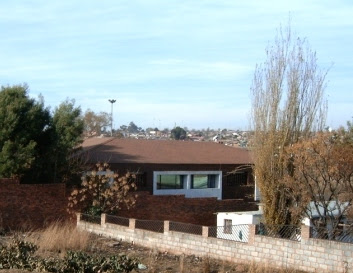Soweto was not what I expected ... this land that is historic for its role in the apartheid struggle is a developing bustling area with the construction of a new stadium and other touristy amenities for the World Cup 2010.

The two water towers are landmarks in Soweto. The first mural displays the culture and heritage of the residents of Soweto. The second pays homage to the bank that financed the power plant these towers service.
The township is divided into class sections. All along the road there are new houses being built for citizens who make less than 4,000 rand annually. These homes are given for free from the government.
The disparity is that directly across the street from the new houses is a shantytown with no electricity or running water. I asked the driver why the government didn't install electricity and water in the shantytown as they are developing the other side of the road. The waiting list for free housing is years long, why doesn't the government offer some relief during this period. He replied that the people in the shantytown are squatters on the government's land.


The houses are made with scrap metal and have tin walls and roofs. The line of porta- potties line the hill of the shanty town.
Soweto is famous for Vilakazi Street - the only street that was home to two Nobel Peace Prize winners. We drove by Bishop Desmond Tutu's family home {though he resides primarily in Capetown now} and we went on a tour of Nelson Mandela family home, which is now a museum.
We also drove by Winnie Mandela's home. Winnie Mandela is an unequivocal hero the South African people. The tour guide as well as the museum guide spoke to her valor and universal respect to the people and the ANC (african national congress). Our tour guide said, "the people of South Africa understand why she had the boy killed. He was a spy for the National Party (apartheid government) and because she was a public figure she had him killed quietly. But normally he would have been killed in the street. Other people may not understand the way this war was fought.... But Winnie Mandela earned her name and respect."
The palatial house she currently lives in was built before the divorce and was supposed to be a grand place to host international visitors, The home has high security gates and is by far the largest we saw in Soweto.
Winnie Mandela has a beautiful garden that is open to the community.
On June 16, 1976 thousands of black South African Students gathered at Orlando West Junior School for a mass rally organized by the Soweto Students' Representative Council’s Action Committee. The SSRC was formed as students went on strike from public school, protesting the Afrikaans Medium Decree of 1974 which forced all black schools to use Afrikaans in instruction. The students rebelled against being taught in the "language of oppression."
On June 16th a crowd of between 3,000 and 10,000 students began the march from Morris Isaacson High School and Naledi High School to join other students in protest at Orlando High.
The students began the march only to find out that police had barricaded the road along their intended route. The leader of the action committee asked the crowd not to provoke the police and the march continued on another route, eventually ending up near Orlando High School.
The police opened fire on the children, causing a stampede and full out riot. One survivor account describes the scene, "They opened fire. They did not give any warning. They simply opened fire. Just like that. Just like that. And small children, small defenseless children, dropped down to the ground like swatted flies. This is murder, cold-blooded murder."
In an attempt to protect themselves, the children began throwing sticks, rocks, bricks, schoolbags, or whatever they could pick up off the ground. The fighting continued for hours and when the smoke cleared there were more than 500 fatalities, though the original government count was 23, and an estimated 1,000+ injured.
The image below is the immortalized picture of Hector Pieterson's dead body, being carried by Mbuyisa Makhubu and Antoinette Pieterson. This image became the international face of the Soweto Uprising and was taken on our visit to the Hector Piertson Memorial.
The everflowing waterfall at the memorial is symbolic of the children of the Soweto Uprising's tears.







No comments:
Post a Comment